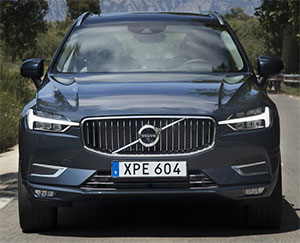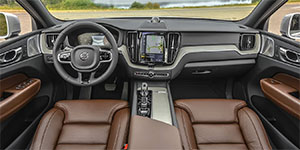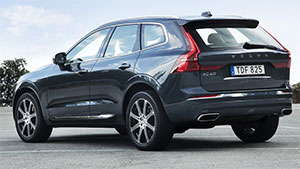2018 Volvo XC60
After reenergizing the brand with the 2016 XC90 crossover, and following up with an all-new S90 luxury sedan and V90 wagon, Volvo turned their sights to the midsize arena with an all-new XC60 utility. Most of what you see here looks familiar. So, let’s see if that XC90’s brilliance survives a bit of downsizing.
Volvo didn’t think too far outside of the box for their midsize 2018 XC60 crossover. Rather, they just took the wonderful package that is the XC90 and downsized it. Well, like most things, it’s not quite that simple.
It does ride on the same platform, which means you also have the same powertrains; starting with a 2.0-liter turbo I4, which at 250-horsepower is more than enough for most, add a supercharger and it bumps up to 316-horsepower. Finally, tack on some electric assist, and output for our T8, jumps to 400-horsepower and 472 lb-ft. of torque.
No matter which version you choose, all-wheel-drive is standard, and all have an 8-speed automatic transmission.
 Nothing drastically different underneath, just a revised version of the double wishbone front and transverse leaf spring rear suspension. So, street handling is sound; making the XC60 reasonably entertaining as a daily driver.
Nothing drastically different underneath, just a revised version of the double wishbone front and transverse leaf spring rear suspension. So, street handling is sound; making the XC60 reasonably entertaining as a daily driver.
Power is plentiful at all times and smoothly delivered; whether merging on the highway, coming out of curves, or leaving a stop light. Our only driveline quibble is some clunky downshifts at low speed, and a very unrefined feel to this plug-in hybrid’s regenerative braking.
Inside, you’ll find the high-end expert-level handcraftsmanship of the 90, but with a modified layout and approach. The overall feel is still high on luxury; and perhaps more impressive, many interior measurements are barely different than the XC90.
In fact, rear seat room actually feels more plentiful, since the 5-passenger XC60 doesn’t need to create access for a 3rd row like the XC90.
Much less cargo space than the 90 of course, but still plentiful for a midsize; at 29.7 cubic-ft. worth of gear in the back; expanding to 63.3 with rear seatbacks folded.
A “love it or hate it” central control tablet dominates the center stack. Mounted in the dash, glare was not a big problem. It’s very easy to do basic things too, but more involved demands require a few menus to go through and taking your eyes off the road more than we’d like.
 Seats are very comfortable in a way that only Volvo seems to have mastered, and near perfect seat height makes getting in almost like sliding into your favorite recliner.
Seats are very comfortable in a way that only Volvo seems to have mastered, and near perfect seat height makes getting in almost like sliding into your favorite recliner.
Now, your recliner probably can’t get you to 60 in less than six seconds, however; and this XC60 T8 has no problem doing that.
It’s not so much a launch off the line, as it is an explosion of energy. We’re still not sure how this little 4-banger manages to hold together with a turbo and a supercharger feeding in boost, but it’s quickly becoming a favorite of ours. The added electric assist is just positively charged ionic icing on this 3-layer cake.
We hit 60 in 5.4-seconds. The automatic transmission shifts quickly and aggressively, and this power unit even sounds pretty good. 13.9 was our ¼-mile time at 99 miles-per-hour.
 With less wheelbase, we were surprised it didn’t feel quite as agile, or for that matter refined, as the XC90 through our cone course. But, there was decent feedback and only mild understeer.
With less wheelbase, we were surprised it didn’t feel quite as agile, or for that matter refined, as the XC90 through our cone course. But, there was decent feedback and only mild understeer.
Where the XC60 mirrors its larger sibling the most is exterior design. It’s not quite an exact copy, but pretty darn close. And that’s just fine by us, why re-engineer a good thing. The front end is a little more rounded, and greenhouse chopped a little.
The government gives the T8 a Combined MPGe Rating of 59, with an overall Combined rating of 26; which we couldn’t quite match with our average of 24.2 miles-per-gallon of Premium. For a very good Energy Impact Score with yearly consumption of just 7.3-barrels of oil, with CO2 emissions of 3.3-tons.
And lest we forget, this plug-in also has an EV-only range of 18-miles.
It may not be quite the value that the XC90 was when it first came out, but the base XC60 is still very reasonable, priced at $43,895.
So, the 2018 Volvo XC60 may be just a scaled down XC90. But that also means it is yet another fantastic product from the new Volvo. One that should have no problem standing out in a crowded field of great luxury utilities.
Specifications
- Engine: 2.0 liter
- Horsepower: 400
- Torque: 472 lb-ft.
- 0-60 mph: 5.4 seconds
- 1/4 mile: 13.9 seconds @ 99 mph
- EPA: 59 MPGe
- Energy Impact: 7.3 barrels of oil/yr
- CO2 Emisiions: 3.3 tons/yr
2025 Volkswagen ID. Buzz
Volkswagen Brings Beetlemania Level Of Excitement To Minivan Segment
The duty of upholding Volkswagen’s heritage has most recently been delegated to small legacy car names like Golf and Jetta. But hold on! A much larger, totally modern take on VW’s classic microbus has just buzzed over the horizon— the all-electric ID. Buzz. It’s been at the top of our minds since we first saw the concept back in 2017. Well, it’s finally here, so let’s get our groove into drive!
This 2025 Volkswagen ID. Buzz has indeed created the most buzz around Volkswagen since the Beetle’s return to the U.S. in the late 1990s. We couldn’t drive it anywhere without drawing a crowd. No wonder, just about everyone has a VW Microbus story to tell, and seeing this reimagined version rolling down the street brings back all those memories.
VW really pulled it off as far as we’re concerned, as it looks great without appearing over the top. All the cues are here: Big VW logo front and center, lots of greenhouse including A-pillar windows and mini sliders for the second-row passengers, D-pillar air vents, and two-tone wheels. And while its appearance may be pure retro, its drivetrain is far from it, as the ID. Buzz is all-electric, and unlike the new Beetle, the Buzz does retain the original Microbus’ rear-drive architecture.
Powering those rear wheels is a 210-kW motor drawing juice from a 91-kWh battery for a range of 234 miles; 200-kW max charging will get you to 80% in about 26 minutes. Buyers can add another small 80-kW motor up front for 4motion all-wheel-drive and an increase of total output from 282 to 335 horsepower with a combined 512 lb-ft of torque. It uses the same battery, but range estimates drop just slightly to 231 miles. But while those numbers are modest, we also found them to be quite conservative, as we observed as many as 287 miles available in our all-wheel-drive tester’s gauge display and were on pace for 273 miles in our driving loop.
One throwback theme that may be a turnoff to some is that it’s quite a step up into the Buzz’s front seats, but there’s certainly a commanding view of the road once you climb in. Second row seating can be either a three-place bench or a pair of captain’s chairs, so there’s generous room for seven or six passengers. The captain’s chairs in our Pro S Plus offer good support and very easy access to the third row.
Lots of flexibility too with the option to simply fold the seats or remove them altogether.
With the sliding side doors and a wide opening rear hatch, there’s plenty of access for loading big sport utility amounts of cargo. Lots of flexibility too with the option to simply fold the seats or remove them altogether, and the ability to create a full-length flat floor with a rear cargo shelf that covers some handy removable storage bins. There’s 18.6 cubic-feet of space behind the third row, 75.5 behind the second, and a max of 145.5. That’s more than a Chevrolet Tahoe. For smaller items, there are lots of cubbies throughout the cabin, along with a standard Buzz Box that can be moved to multiple locations.
With a design that prioritizes retro form and modern function over aero efficiency, the 4motion equipped ID. Buzz earns a Fair efficiency rating, using 42-kWh of electricity per 100 miles, and we weren’t sure what to expect at our Mason Dixon test track.
What we found was great torque off the line and drama free launches to 60 in just 5.3 seconds. It was very stable at speed and power delivery stayed steady most of the way down the track until we reached about 90 mph, when it began to taper off just before we finished the quarter-mile in 14.0 seconds flat at 97 mph.
With 1,200-lbs. of battery weight nestled in its 127.5-inch wheelbase, the Buzz felt planted to the pavement through our handling course. There was quite a bit of body roll to deal with, but surprisingly little understeer. In panic braking runs, pedal response was inconsistent, feeling soft at times, pushing back hard at others; but through it all, results were quite good, stopping from 60 in an average of just 108 feet.
Three interior themes are available, this Dune is the brightest, featuring coastal inspired wood optic dash décor, “gray and clay” leatherette surfaces, and a high-mounted central 12.9-inch touchscreen. Pricing starts with a rear-wheel-drive Pro S at $61,545; this Pro S Plus begins at $65,045, add another $4,500 for 4motion, which brings a few extra features along with all-wheel drive.
Retro design with old-school VW charm, modern EV drivetrain, big SUV capacity merged with minivan flexibility; it all comes together in this 2025 Volkswagen ID. Buzz. It’s easily one of the coolest rides of the year and one that will likely keep Volkswagen dealers buzzing for years to come, and that’s something no other people and things mover can say.
Specifications
As Tested
- Motor Setup: Dual-Motor AWD
- Battery Size: 91-kWh
- Horsepower: 335
- Torque: 512 lb-ft
- EPA Range: 231 miles
- 0-60 mph: 5.3 seconds
- 1/4 Mile: 14.0 seconds at 97 mph
- Braking, 60-0: 108 feet
- MW Test Loop: ~ 273 miles













































